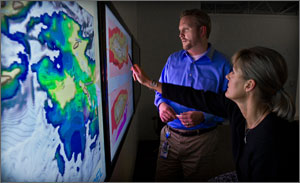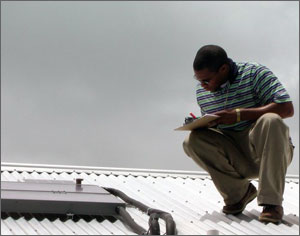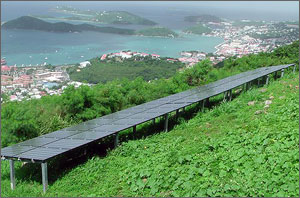NREL Helping Virgin Islands Cut Fuel Use
January 11, 2012
 Enlarge image
Enlarge image NREL's Adam Warren, left, and Karen Petersen examine a map that shows the wind and sun resources of the U.S. Virgin Islands.
Credit: Dennis Schroeder
Credit: Dennis Schroeder
The tiny U.S. territory in the Caribbean has just 110,000 residents, all the beach, surf, wind and sun you'd ever want, but energy prices that are four to five times higher than are paid in the continental United States.
Like many islands on earth, the USVI are almost 100 percent dependent on imported oil for electricity. Residents pay about 47 cents per kilowatt hour to light their homes and run their appliances. Imported oil is even used to desalinate the water because there is so little fresh water available other than what residences catch on their roof in the form of rain water.
But USVI Gov. John P. de Jongh Jr., working with the U.S. Department of Energy's National Renewable Energy Laboratory (NREL) and the U.S. Department of Interior, has vowed to transform energy use dramatically. In January, at his State of the Territory address, he announced the goal of reducing use of fossil fuels by 60 percent in the next 15 years.
That's huge, and a great challenge, and just possibly a blueprint for how to achieve those similar reductions on the mainland.
"What we're attempting to do is integrate every large portion of renewable energy into our system," said Karl Knight, the director of USVI's energy office, who also is a board member of the Virgin Islands Water and Power Authority. Think of it as a pilot for how to integrate renewables as a large proportion of the grid."
To get there, a half dozen different technologies need to be implemented, and energy efficiency will have to become a rallying cry.
A Recipe for Energy Savings
 Enlarge image
Enlarge image On a rooftop in St. Croix, U.S. Virgin Islands, an Energy Office intern inspects a solar collector.
Credit: Don Buchanan, USVI Energy Office
Credit: Don Buchanan, USVI Energy Office
The United States, New Zealand, and Iceland are three of the leading actors in the international partnership, Energy Development in Island Nations (EDIN), and for the United States, its Virgin Islands territory was a natural fit.
"We wanted to help USVI particularly because the governor was very committed to transforming the energy infrastructure, as was the CEO of their utility," NREL's Adam Warren, who heads NREL's EDIN program, said.
NREL has helped USVI — its government, utilities and public and private groups — to map the renewable energy potential, and to determine how to get to a 60 percent reduction by 2025. Early on, NREL produced a major technological report on grid integration, transmission and distribution.
"We think 60 percent is very realistic," Knight said. "The government established that goal in collaboration with NREL and the Island Nations global partnership. They challenged Gov. deJongh to be aggressive in his goal-setting and he took them up on it. We established the aggressive goal because we spend so much on The only thing that people in the Virgin Islands talk about is the size of their electric bills."
The high rates have hurt low-income residents and have been a deterrent to economic investment, Knight said. "If the rate is going to be 40 cents a kilowatt hour or more, it shapes the type of business that's willing to locate in the Virgin Islands," he said. "Our total dependence on oil for power generation in an era of expensive crude oil is having a huge impact."
USVI burns 2.6 million barrels of oil each year to generate electricity and desalinate water.
The recipe to achieve a 60 percent reduction:
2 percent biomass
3 percent landfill gas
3 percent solar
6 percent wind
8 percent waste-to-energy
38 percent energy efficiency
NREL's Karen Petersen said the most cost-effective way to reduce fossil-fuel use — the low-hanging fruit, so to speak — is "to help the utility become more efficient in its operations." Simple measures such as turning off lights in buildings and lowering the air conditioning use in tourist hotels also will help immensely.
"We're working to create a whole cultural shift," Petersen said. "They're very conservative in their use of energy because of need, but it doesn't necessarily revolve around an environmental ethic."
Island residents "had a healthy dose of skepticism" when the plan for more solar, wind and biomass was proposed because past proposals haven't kept their promises, Knight said. "But we have tried to convince the community that we're not promising lightning in a bottle. This is a 15-year strategy," Knight said. "We're using tried and commercially proven technologies, gathering up the best practices and working in close consultation with energy experts such as the folks at NREL.
"This is not a developer selling some Star Trek technology that is going to save the day," Knight added. "It's is going to be a gradual build-up to what we believe is a successful achievement of our goals."
Energy Transformation Isn't Easy
 Enlarge image
Enlarge image The idyllic view of the coastline on St. Thomas, U.S. Virgin Islands, on Skyline Road near the capital Charlotte Amalie isn't spoiled by a 10-kilowatt photovoltaic system
Credit: Don Buchanan, USVI Energy Office
Credit: Don Buchanan, USVI Energy Office
"That's why we work with the entire community," said Warren. "In the past, they've seen systems go in by these fly-by-night developers that don't work the way they're supposed to.
"You need everyone on board — government, the private and public sectors to get something that big," Warren said. "We set up working groups to attack different areas — efficiency, renewables, transportation."
That's been key, Knight said. "We've been able to secure some good partnerships that have really put some effort into helping us achieve the goal. Through the assistance of NREL, we've established local working groups, both public sector and private sector and the participation of non-government organizations."
Some 80 percent of the USVI's economy is dependent on tourism. Tourist hotels use much more electricity, especially in the form of A/C, than does the average full-time resident. "If you're not using A/C, most of the load is going toward heating water or keeping the refrigerator cold," Warren said. In all, the household usage is about half of what it is in the United States — 450 kwh per month compared to 900 kwh.
Moving Renewables onto the Grid
One of the thorniest challenges is how to get so much renewable energy on the grid and still have it operate smoothly all hours of the day.
Solar and wind energy are variable — they surge onto the grid when the sun is shining and the wind is blowing, but trickle or stop when the winds calm and the sun sets, or even when a thick cloud passes by.
Happily for the USVI, the highest electrical use is when the sun is shining — and all those tourists want the air conditioning cranked up.
Still, the variability means that distributed systems make more sense. So, USVI likely will have small solar arrays on dozens of rooftops, and just a few of the larger solar projects; likewise, wind energy is likely to be distributed widely, with a mix of small turbines and some larger turbine farms.
Combining wind and solar energy with electricity generated from closed landfills and waste gives a nice balance of variable sources and so-called dispatchable sources — the kind that utilities can ramp up and down to match demand.
Tackling how to load a high rate of renewables onto the grid will help the mainland United States, too. "We as a nation want to figure out the problems associated with a high-penetration of renewables," Warren said. "We hope we can show that first in the islands like USVI and Hawaii.
Islanders Face Tough Choices
Virgin Islanders have heard horror stories about installed renewables that couldn't handle the load because the variability was too much, so part of NREL's job is to show how the proper steps with the right technology can make it a success.Island residents are leery of overloading the grid with too much renewable energy, but they're faced with the reality of 47 cents per kilowatt hour. They're facing serious tradeoffs, Warren said. "Do I pay my electricity bill or do I buy my medication?' is a real question that is forced on many."
"They're motivated to bring renewables on board and to conserve as much as possible because they need to," Petersen said. Businesses are closing daily because of the cost of electricity.
Optimism Grows from NREL/USVI Partnership
Knight is confident, and says NREL's participation has been crucial. "First, it has given the policy-makers the confidence that they're making the right decisions," Knight said. "To have a neutral party to discuss decisions with, to make sure that we are doing what is in the best interest of the population and the governor's goal, gives us and the policy makers credibility. We're able to say to the public, 'this isn't pie-in-the-sky.'"We've sat down with the greatest experts in the nation out in Golden, Colo., and discussed our plans — and they've endorsed them fully. We can tell the most passionate members of our community that we've had conversations with NREL and, yes, they've endorsed the proposed projects."
"Our first and foremost goal is to assist other small island nations to curb their appetites for fossil-fuel-derived energy and to provide a model on the cost and investment return on the latest technologies."
"We're hoping there's a lesson to be learned here to benefit larger systems. Hopefully, we can be the test bed for the rest of the nation and the globe."
Learn more about what NREL is doing to move clean energy technologies into the marketplace.
— Bill Scanlon
Virgin Islands Energy Reduction Plan
U.S. Virgin Islands Gov. John P. de Jongh, Jr., and other dignitaries and energy leaders traveled to the U.S. Department of Energy's National Renewable Energy Laboratory in February of 2010 to sign a memo of understanding that is the centerpiece of the plan to reduce consumption of fossil fuels on the islands by 60 percent.Here are some of the ways NREL and the Island government plan to pare the 2.5 million barrels of oil that were used in 2010.
Solar Energy: Photovoltaics and Solar Hot-Water Heating
Sixty-one thousand barrels can be saved if 40 percent of the USVI households take advantage of incentives to use the sun's energy to heat their hot water.Another 100,000 barrels a year can be saved via capturing photons for electricity. NREL helped design a half-megawatt solar energy system on St. Thomas. "A half a megawatt is small from our standpoint, but is highly visible for the Virgin Islands," NREL's Adam Warren said.
Now, 27 different companies have submitted proposals hoping to be chosen to build a 10-megawatts or more of photovoltaic system by late 2013.
Energy Efficiency
920,000 barrels of oil can be saved via better efficiency, including generation efficiency.A crucial strategy is to switch from a distillation system to a reverse-osmosis system to desalinate the water.
Wind Energy
178,000 barrels a year can be saved with 22.5 megawatts of wind energy. The plan is to deploy a mix of small and utility-scale wind turbines."The southern shore has a good wind resource that would probably come in at about 10 cents per kilowatt hour, vs. the 47 cents they're paying now," NREL's Adam Warren said.
Biomass, Landfill Gas and Waste-to-Energy
380,000 barrels can be saved each year by turning biomass into fuel, capturing and re-using the gas that forms below landfills, and turning waste into energy."We are very much engaged in a very rigorous public discourse on waste-to-energy," Karl Knight, the director of USVI's energy office, said. "People are concerned about emissions, as well as its impact on promoting recycling and waste reduction. But we believe using the best practices available those concerns about emissions can be addressed."
No comments:
Post a Comment
Note: Only a member of this blog may post a comment.